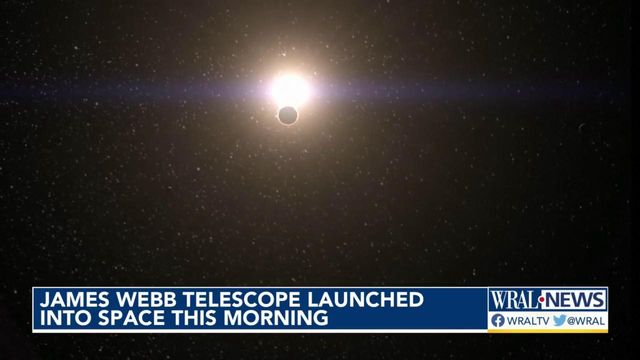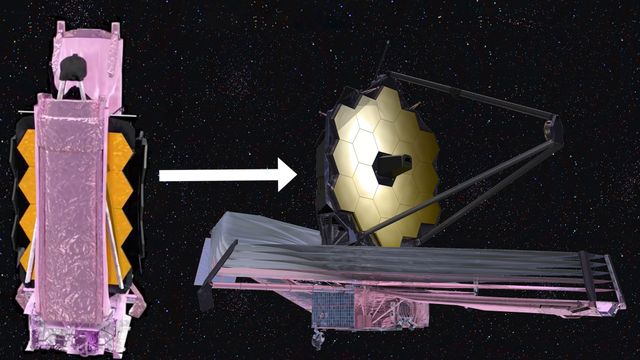NASA telescope bearing name of NC native launched into space in hopes of revolutionizing understanding of deep space
After a delay, it's all systems go for the launch of the world's most powerful observatory. The James Webb Space Telescope will be launched into space on Saturday. Webb is a Granville County native and UNC-Chapel Hill graduate.
Posted — UpdatedIn a moment that was decades in the making, the James Webb Space Telescope, NASA's premier space observatory of the next decade, successfully launched on Saturday morning.
The telescope lifted off atop an Ariane 5 rocket from Europe's Spaceport in French Guiana at 7:20 a.m. ET.
James Webb, North Carolinian
The telescope is named after former NASA head and North Carolina native James Webb. Webb, a Granville County native, graduated from Oxford High School in 1923 and went on to earn a degree in education from the University of North Carolina at Chapel Hill.
Webb’s skills as an administrator, his military and government finance experience and his experience leading complex scientific projects led then-Vice President Lyndon B. Johnson to offer him the position of NASA’s head. Though initially reluctant, thinking an engineer or scientist would be a better choice, Webb went on to guide the agency through its largest build up ever, during the Mercury, Gemini and Apollo programs.
“Without James Webb’s leadership, there may have been no telescope or much of anything else at NASA noteworthy of a naming controversy,” said Sean O’Keefe, NASA Administrator during the Webb Telescope's early days.
Risky launch: 'Rockets can blow up'
When asked "are you nervous about the James Webb Space Telescope launch?", an astronomer friend who depends on space telescopes in his research of topics like what happens as galaxies merge had a simple answer:
"Absolutely, rockets can blow up."
The successful launch of the Webb telescope atop the Ariane 5 rocket provided by the European Space Agency in this international project is just the beginning of what is being called "two-weeks of terror" though.
The launch of the James Webb Space Telescope is one of those missions. But this is new ground for NASA and its European and Canadian Space Agency partners.
The launch of the Mars rovers Curiosity in 2011 and Perseverance in 2020 only retired about 10%-20% of the overall risk. The rest had to wait for months until rovers reached Mars and descended through the thin atmosphere over what was called the "seven-minutes of terror."
The successful launch of the Webb telescope will retire an even smaller part of the overall risk.
A recent risk review found 344 single points of failure, individual steps in the process to unfold Webb from less than 17-feet wide to its final 70-foot wide configuration. This exceeds the single point of failure in the Mars rover landings by a factor of 3 according to Zurbuchen.
The Curiosity and Perseverance landings were nearly flawless. Curiosity was aiming for a 12 by 4 mile ellipse and touched down about 1.25 miles from its target. Perseverance's ellipse was reduced to 5 by 4, and it landed within 16 feet of its target.
But there was little those Mars mission controllers could do but hope they'd anticipated everything the car-sized robots needed to do to get to the surface safely.
Only the initial deployments of Webb's the solar panels and antennae will be automatic. Ground controllers will carefully unfold the telescope during the 30 days spent crossing the million miles to its final destination.
Launch day just the start
The Ariane 5 launch vehicle, provided by the European Space Agency, will fire its engines for nearly 30 minutes before the upper stage separates to push the telescope toward its final orbital destination a million miles from Earth. At this point Webb is already 19 times further from Earth than the Hubble Space Telescope.
Day one, 134,000 miles from Earth
The beam sent by that high gain antenna starts out just a few inches across, but it will be as wide as the Earth itself after traveling those million miles.
Day three, 282,000 miles from Earth
Ground controllers with spend the next day going through a series of checks to help ensure everything is ready for a series of nearly 40 deployments. But first they'll turn on heaters to ensure the motors, latches, springs and pulleys that will continue unfolding the telescope in the coming weeks will work as designed.
The next component to deploy is the Unitized Pallet structure (UPS) containing the sunshield which will block the heat and electromagnetic noise from the Earth and the Sun, providing the cold, dark, and quiet environment the telescope needs to do its job
Next, a motor raises the tower where the telescopes mirrors and instruments are mounted to provide enough room for the sunshield to deploy. This also puts more distance between the those sensitive instruments and the rest of the spacecraft.
Day five, 381,000 miles from Earth
Over the first half of day five, covers that have protected the thin sunshield layers will rollback. Then the tennis-court sized sunshield will carefully begin deploying as booms on either side extend, taking along 5 layers of Kapton polymer film, each more than 1,000 times thinner than a human hair.
The sunshield's material is surprisingly strong. If and when the layers are hit by micrometeoroids, the material is designed not to rip further.
Day six, 421,250 miles from Earth
Over the next two days, each layer will be tensioned and separated. The near-vacuum of space between the layers does a good job of providing the insulation needed for the telescope's instruments operate. The "hot side" of the sunshield will be a toasty 185ºF while the cold side remains below -388ºF.
At this point, the fully deployed sunshield can also act as a giant sail. To help prevent the mission from being blown off course, a special flap is deployed to counteract the effects of the solar wind.
The telescope will cruise for three more days, cooling further as it goes.
That -388ºF cold side is low enough enough for some of the telescope's instruments to do their job. A cryocooler starts up on day nine to bring the Mid-Infrared Instrument (MIRI) down to the few degrees above absolute zero needed to detect the faint remnants of the big bang when science operations start about six months after launch.
Day eleven, 592,000 miles from Earth
The telescope starts to take shape as the secondary mirror is moved into its operational position, out in front of the primary mirror. That 29-inch wide secondary mirror, about the size of Captain America's shield, reflects light gathered by the primary mirror to the instruments behind the primary mirror.
Day twelve, 622,000 miles from Earth
The left and right row of primary mirror segments are next moved into place completing mirror assembly.
Unlike the Hubble Space Telescope, the round secondary mirror along with each of the 18 hexagonal segments that make up the primary mirror have actuators which can be used to independently adjust the curvature of each. This is important because, unlike Hubble, servicing the Webb telescope will not be possible.
The mirrors have a total surface area of about 270 square feet. They weigh about 1,500 pounds but the thin (100 nanometers) gold coating makes up only 48 grams (about the weight of a golf ball). Gold was selected because of its highly reflective properties, particularly with infrared light.
Month 1, 1 million miles from Earth
If needed, a mid-course correction is built into the plan on day 29, to put Webb into its final operational position, in orbit around L2, or Lagrange Point 2, named for Joseph-Louis Lagrange who helped find these points of gravitational balance between the Sun, Earth and Moon
Controllers hope to never fire the spacecraft's engines to get it into an accurate orbit. The mission is planned for 5 years, but there are enough consumables, like fuel for those engines, to extend the mission to 10 years should everything go well
Related Topics
• Credits
Copyright 2024 by Capitol Broadcasting Company. All rights reserved. This material may not be published, broadcast, rewritten or redistributed.






